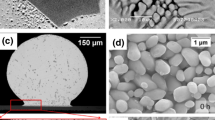Abstract
In the present work, a quantitative phase-field approach is introduced to study the phase-coarsening phenomena in solder alloys, Pb-Sn alloy here. The most important part of this work is to introduce a simple and versatile approach to quantify the experimental and simulation data, without putting into difficulties corresponding to the stochastic nature of phenomenon, in order to compute unknown physical data required to perform numerical simulation. For this purpose, at first, the evolution of microstructure vs. time is studied experimentally by the conventional optical microscopy. Then, unknown physical data, the interface mobility here, is computed by fitting the time evolution of the total interface perimeter of the simulation results to that of the experimental data. In fact, by this approach, the physical data is computed such that it will be applied to predict reality in the subsequent simulations, i.e., the presented method can be accounted as the calibration of the corresponding mathematical model and numerical method. The validity of the presented approach is supported by comparing simulation data to experimental ones.








Similar content being viewed by others
References
Ubachs, R.L.J.M., Schreurs, P.J.G., Geers, M.G.D.: A nonlocal diffuse interface model for microstructure evolution of tin–lead solder. J. Mech. Phys. Solids 52, 1763–1792 (2004)
Chan, Y., Yang, D.: Failure mechanisms of solder interconnects under current stressing in advanced electronic packages. Prog. Mater. Sci. 55, 428–475 (2010)
Bonda, N., Noyan, I.: Deformation inhomogeneity and representative volume in Pb/Sn solder alloys. Metall. Trans. A, Phys. Metall. Mater. Sci. 23, 479–484 (1992)
Basaran, C.: Measuring intrinsic elastic modulus of Pb/Sn solder alloys. J. Jiang Mech. Mater. 34, 349–362 (2002)
Hacke, P., Sprecher, A., Conrad, H.: Microstructure coarsening during thermo-mechanical fatigue of Pb–Sn solder joints. J. Electron. Mater. 26, 774–782 (1998)
Conrad, H., Guo, Z., Fahmy, Y., Yang, D.: Influence of microstructure on the plastic deformation kinetics, fatigue crack growth rate, and low-cycle fatigue of solder joints. J. Electron. Mater. 28, 1062–1070 (1999)
Jung, K., Conrad, H.: Microstructure coarsening during static annealing of 60Sn40Pb solder joints: I stereology. J. Electron. Mater. 30, 1294–1302 (2001)
Jung, K., Conrad, H.: Microstructure coarsening during static annealing of 60Sn40Pb solder joints: II eutectic coarsening kinetics. J. Electron. Mater. 30, 1303–1307 (2001)
Matin, M., Vellinga, W., Geers, M.: Quantitative Microscopy of Microstructural Evolution in Eutectic Solders Subjected to Static Thermal Load, pp. 111–116. Shaker Publishing, Aix-en-Provence (2003)
Cahn, J.W., Hilliard, J.E.: Free energy of a nonuniform system I: interfacial free energy. J. Chem. Phys. 28, 258–267 (1957)
Cahn, J.W.: Spinodal decomposition. Trans. Metall. Soc. AIME 242, 166–180 (1968)
Dreyer, W., Muller, W.H.: A study of the coarsening in tin/lead solders. J. Mater. Sci. 37, 3841–3871 (2000)
Dreyer, W., Wagner, B.: Sharp-interface model for eutectic alloys part I: concentration dependent surface tension. Interfaces Free Bound 5, 199–227 (2005)
Böhme, T., Dreyer, W., Müller, W.H.: Determination of stiffness and higher gradient coefficients by means of the embedded-atom method. Contin. Mech. Thermodyn. 18, 411–441 (2007)
Boettinger, W.J., Warren, J.A., Beckermann, C., Karma, A.: Phase field simulation of solidification. Annu. Rev. Mater. Res. 32, 163–194 (2002)
Muller, W.: Changes in solder joints-experimental evidence and physical understanding. Microelectron. Reliab. 44, 1901–1914 (2004)
Dreyer, W., Muller, W.H.: Modeling diffusional coarsening in eutectic tin/lead solders: a quantitative approach. Int. J. Solids Struct. 38, 1433–1458 (2001)
Cox, S.M., Matthews, P.C.: Exponential time differencing for stiff systems. J. Comput. Phys. 176, 430–455 (2002)
Kassam, A., Trefethen, L.N.: Fourth-Order time stepping for stiff PDEs. SIAM J. Sci. Comput. 26, 1214–1233 (2005)
Brenier, Y., Otto, F., Seis, C.: Upper bounds on coarsening rates in demixing binary viscous liquids. J. Soc. Ind. Appl. Math. 43, 114–134 (2011)
Author information
Authors and Affiliations
Corresponding author
Rights and permissions
About this article
Cite this article
Tavakoli, M.M., Tavakoli, R., Davami, P. et al. A quantitative approach to study solid state phase coarsening in solder alloys using combined phase-field modeling and experimental observation. J Comput Electron 13, 425–431 (2014). https://doi.org/10.1007/s10825-013-0551-y
Published:
Issue Date:
DOI: https://doi.org/10.1007/s10825-013-0551-y




